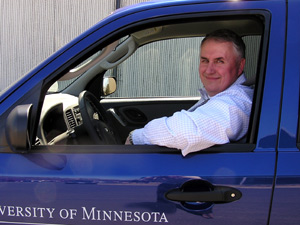|
Photos
Resources
|
April 20, 2005
 |
| Bill Roberts shows off the new Ford Escape Hybrid. The SUV is popular with University of Minnesota employees who rent vehicles from the U's Fleet Services. (MPR Photo/Lorna Benson) |
St. Paul, Minn. — When Toyota introduced its Prius gasoline-electric hybrid in the U.S. the car generated a lot of buzz, but not a lot of sales. In 2001, only about 15,000 Americans bought a Prius. Compare that to Ford Motor Company which sold nearly 911,000 F-Series trucks that same year.
Four years later hybrids are catching on. Last year Toyota sold 50,000 Priuses in the U.S. This year, the company expects to top 100,000.
Paul Eisenstein, publisher of Thecarconnection.com, an automotive website, says hybrids are becoming more popular as fuel costs continue to rise.
"That's triggering a lot more people to think about hybrids as an alternative to the conventional gasoline engine," says Eisenstein. "What's interesting is that the higher prices go, the more logical a case it makes for owning a hybrid."
Hybrids are more fuel efficient than gas-only vehicles, but it hasn't made sense to buy one solely to save money on gas. That's because hybrids cost more, typically several thousand dollars more than similar sized cars and trucks. So even with gasoline at $2.00 a gallon, most motorists who buy a hybrid still have to drive their vehicle from four to seven years to break even, depending on how many miles they drive each year.
But if gas prices keep climbing as some economists predict, Paul Eisenstein says the fuel equation changes.
"When you're starting to get up to $3.00 a gallon, the payback comes faster and faster," Eisenstein says.
Still, it's possible there's a another reason consumers are buying more hybrids. It could be that they're finally finding cars that meet their needs. Early hybrids were cramped and short on comforts. But that's no longer the case with some of the new hybrids.
This year Toyota is introducing two sport utility vehicles. General Motors offers two hybrid pick-up trucks. Ford recently rolled out its hybrid SUV, called the Escape.
Bill Roberts received three Escapes. Roberts directs the University of Minnesota's Fleet Services, a car rental facility serving University employees.
"You can see from the outside they look exactly like any other Ford Escape vehicle," Roberts says. "You can't tell any difference. It's when you open up the hood that you can see it's quite a bit different vehicle."
Roberts points to an Escape parked near the beginning of a long row of spotless vehicles that trail away into a cavernous garage on the northern edge of Minneapolis. Roberts says the Escape is so popular with his customers that's it's unusual one is sitting here at this moment.
The U of M's Escapes average about 24 miles to the gallon, according to Roberts. It's supposed to get 33. Still, he isn't too concerned. Roberts says it's better than his Chevy S-10 Blazer which is the same size and only gets 13 miles to the gallon.
But he's most impressed with the interior space in the new Escape hybrid.
"I'm a big guy. My previous car was a Bonneville. I now have a Cadillac CTS," says Roberts. "So the idea that I'm gonna buy some sub-compact car just doesn't work for me. And I think they've now come to the conclusion that to sell em mainstream they've got to put em in the cars that people buy."
After driving the Hybrid Escape, Roberts says he's tempted to buy one.
Steve McCormick of St.Paul just bought a new Toyota Highlander hybrid. It will be his third hybrid. He also owns a Prius and he had another one before that.
McCormick doesn't have his Highlander yet, because the SUV isn't released until June. Once he gets it, he says he will get rid of his full-size Tundra pickup that he uses to haul his boat.
"I feel that it's foolish to drive something like that unless you need to carry refrigerators or tools or something in your job," says McCormick.
Most Minnesotans don't haul refrigerators. But many do use their vehicles to haul livestock, farm equipment or pull a camper.
Paul Eisenstein says most new hybrids probably are not capable of that kind of towing.
"If you are using a lot of power when you're going up and down steep hills, you're gonna draw down the battery," says Eisenstein. "So hybrids are not the solution for everybody."
Eisenstein thinks advances in diesel technology are more promising. He says diesel vehicles get better mileage, they're more powerful and they're not as polluting as they used to be. But Eisenstein says diesel has such a bad reputation to overcome, that it probably will be a while before Americans are ready to embrace the fuel.
He says it is encouraging that consumers are demanding more hybrids. It's still not a groundswell, but he says it's a good start.




